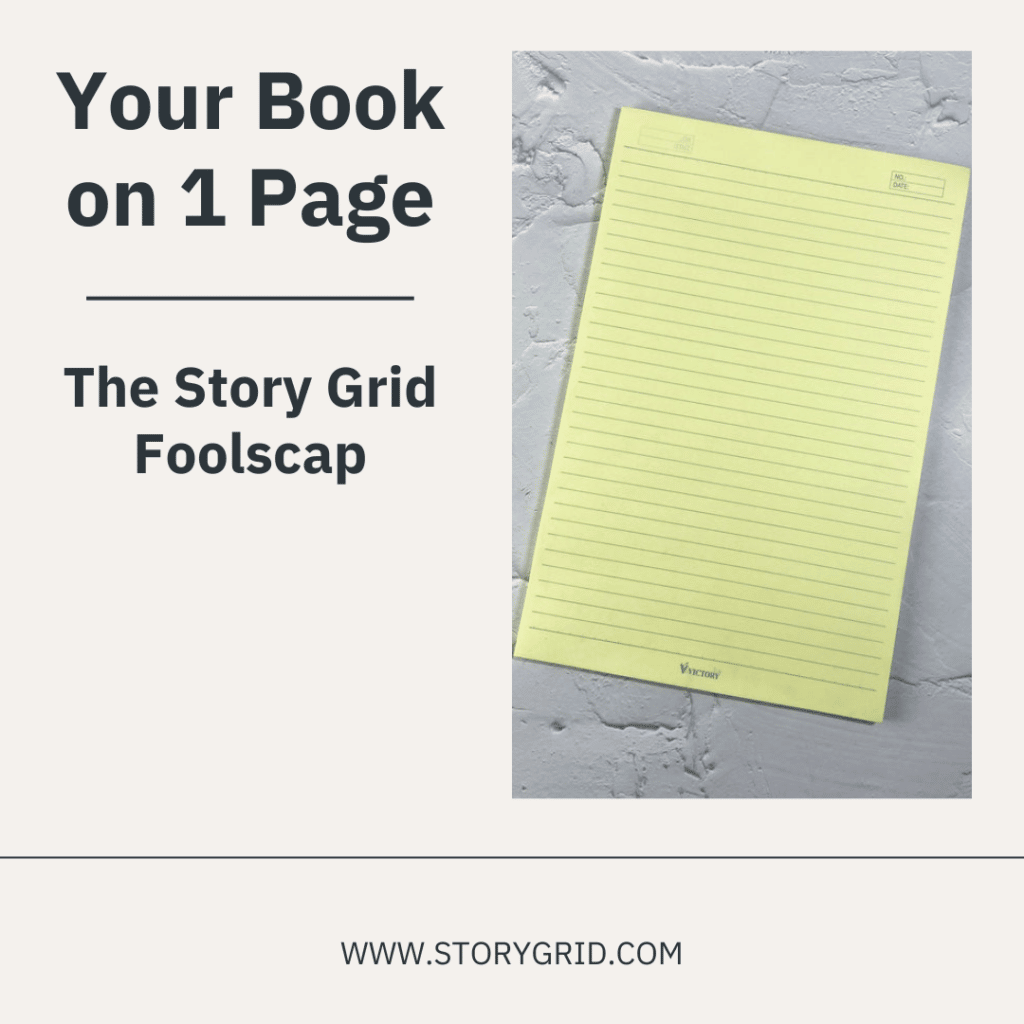How do you put your whole book on 1 page?
While drafting or revising their novels, story writers often need a 30,000-foot, 1-page book plan for their stories to avoid going off track. To gain this perspective, they may try to work from memory or search through notes in a plan that is many pages long. Either way, the information they need to solve their problems remains elusive, and distraction can quickly lead to resistance.
At Story Grid, we know it’s important to record thoughts and ideas as we plan because they spark new creativity. But these notes can hinder the drafting and revision process if we become mired in the details. We also know our memory isn’t a substitute for clear and concise entries of the who, what, where, when, how, and why of our story. That’s why we use the Story Grid Foolscap, a document meant to fill a single sheet of legal-sized paper with the key elements of our global story to keep us on track. It is a quick reference that helps us to make story decisions so every UNIT OF STORY contributes to our compelling story.

What are the key features of the Foolscap 1-Page Book Plan?
Genre
GENRE is a label that tells audience members what to expect from our stories, and the global and secondary CONTENT GENRES tell us what the story is about. The Content Genres are shortcuts that immediately remind us of the CORE NEED and CORE VALUE at stake in the story to generate the CORE EMOTION in our audience. If our scenes aren’t incorporating these needs and values, then we know they need to be revised or cut.
Conventions
CONVENTIONS are genre specific requirements for the story’s ALTERNATE WORLD, AVATARS, and catalysts that create conflict and enable solutions. Genre Conventions remind us of the who and where of our story and set up genre audience expectations and create the potential for specific change in the Obligatory Moments of a story.
Obligatory moments
OBLIGATORY MOMENTS are the key events in every story that cause VALUE SHIFTS and pay off reader expectations. Reminding ourselves of these must-have scenes lets us be aware of the setups and payoffs we need to embed within the story to create a satisfying ending for our audience. This is how we show the genre-specific change in the story.
Point of view
POINT OF VIEW is a combination of technical choices that when combined with the story’s Narrative Device, determine how we deliver the story to the reader. Consistent point of view choices help us craft a coherent story where readers stay in the flow of the narrative.
Objects of desire
OBJECTS OF DESIRE are what the story protagonist wants, needs, and desires when the story’s INCITING INCIDENT happens. Observing the pursuit of these goals helps readers relate to the protagonist, even when they have little in common. If the protagonist is not going after these goals in every scene, we know we need to revise.
Controlling idea
The CONTROLLING IDEA is the main takeaway of the story or the message we want to communicate. Every UNIT OF STORY should transmit this message. Our controlling idea should guide every sentence we write because it’s the why of our story.
Quadrants
QUADRANTS show the stages of development for the protagonist through their ability to adapt to change in the global CONTEXT. This is how the protagonist transforms. We can use our understanding to help us draft and revise scenes to make sure the protagonist’s behavior conforms to universal story patterns.
How do we use the Foolscap?
Different Story Grid tools help us apply the methodology differently, like wearing a different hat for different stages of the writing journey. We plan our stories using the NARRATIVE PATH and use that to fill in our Foolscap for easy reference while drafting and revising. The Foolscap gives us a concise summary of the key global elements of the story to remind us of decisions we’ve already made. We review our 1-page book plan at the beginning of each work session and keep it handy if we hit a roadblock.
How can a 1-page book plan help your writing now?
Access the Story Grid Spreadsheet template and navigate to the second tab on the bottom of the sheet where you’ll find the Foolscap page. Add the information you know about your story now. Review the Foolscap during every work session and update it as you make new decisions or changes.
Foolscap examples
(The Foolscap can be found by toggling to the Foolscap tab at the bottom of the spreadsheet’s screen.)
Pride and Prejudice:
Pride and Prejudice Story Grid Spreadsheet
Wonderful Wizard of Oz:
The Wonderful Wizard of Oz Story Grid Spreadsheet
Additional Foolscap resources:
- Story Grid Spreadsheet Template
- The Story Grid: What Good Editors Know by Shawn Coyne
- Story Grid 101: The Five First Principles of the Story Grid Methodology by Shawn Coyne
Share this Article:
🟢 Twitter — 🔵 Facebook — 🔴 Pinterest
Sign up below and we'll immediately send you a coupon code to get any Story Grid title - print, ebook or audiobook - for free.
(Browse all the Story Grid titles)